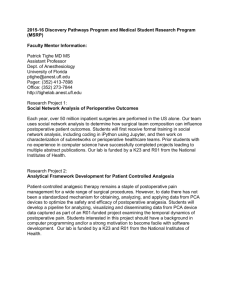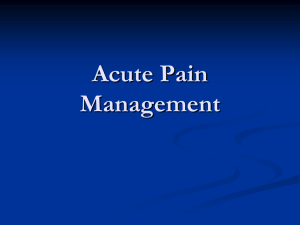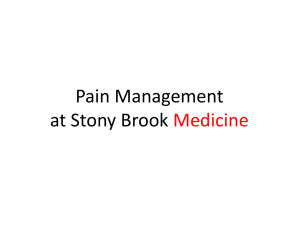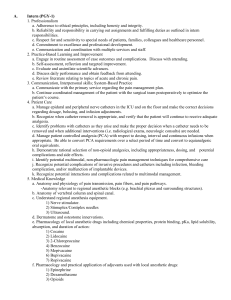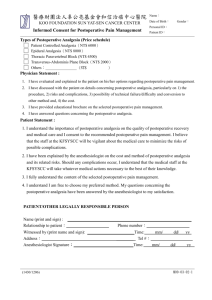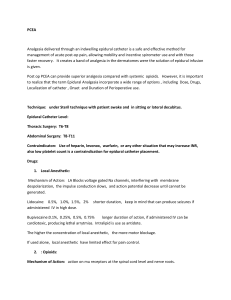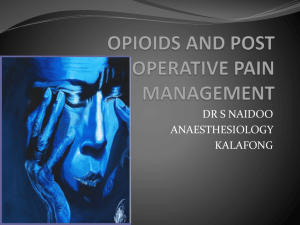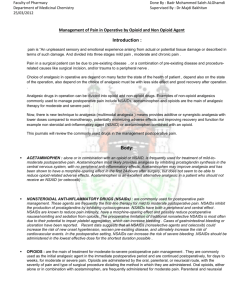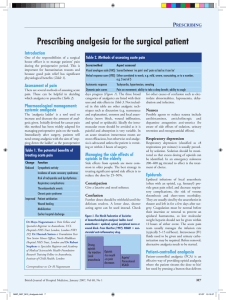LECTURE8-Acute Pain
advertisement
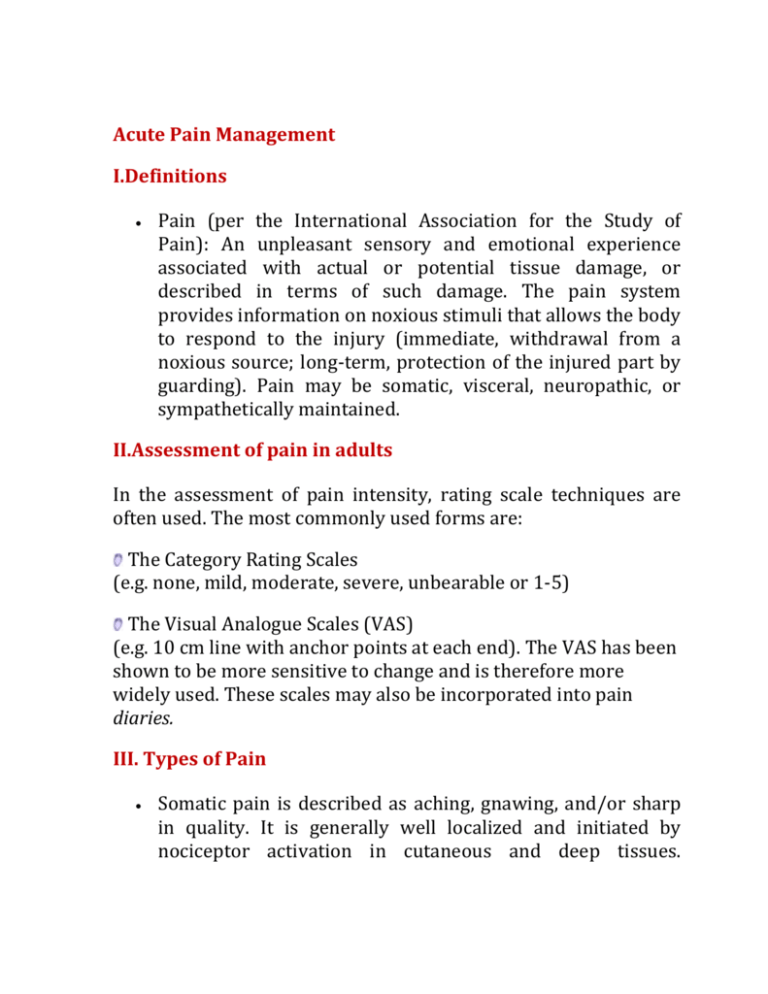
Acute Pain Management I.Definitions Pain (per the International Association for the Study of Pain): An unpleasant sensory and emotional experience associated with actual or potential tissue damage, or described in terms of such damage. The pain system provides information on noxious stimuli that allows the body to respond to the injury (immediate, withdrawal from a noxious source; long-term, protection of the injured part by guarding). Pain may be somatic, visceral, neuropathic, or sympathetically maintained. II.Assessment of pain in adults In the assessment of pain intensity, rating scale techniques are often used. The most commonly used forms are: The Category Rating Scales (e.g. none, mild, moderate, severe, unbearable or 1-5) The Visual Analogue Scales (VAS) (e.g. 10 cm line with anchor points at each end). The VAS has been shown to be more sensitive to change and is therefore more widely used. These scales may also be incorporated into pain diaries. III. Types of Pain Somatic pain is described as aching, gnawing, and/or sharp in quality. It is generally well localized and initiated by nociceptor activation in cutaneous and deep tissues. Examples of somatic pain include acute postoperative pain and bone fractures. Visceral pain is also associated with tissue injury, specifically infiltration, compression, and distention of viscera. It is usually described as dull and aching in quality and poorly localized, and it may be referred to other sites. Examples include abdominal pain due to constipation. Neuropathic pain results from injury to the peripheral or central nervous system (CNS). Shooting, electrical, or burning pain often is superimposed on a chronic background of burning and aching sensations. Examples include postherpetic neuralgia (PHN) and diabetic neuropathy IV. Acute pain Acute pain Basics o Acute pain follows injury to the body and generally disappears with wound healing. It often is associated with physical signs of autonomic hyperactivity. Unfortunately, the most common reason for unrelieved pain is the failure of medical staff to routinely and systematically evaluate the patient's pain and provide adequate pain relief. o Postoperative pain management. Patients expected to have significant postoperative pain should be given adequate treatment before emergence from general anesthesia. The sudden onset of severe pain during recovery can lead to emergence delirium, undesirable cardiovascular effects, and impaired ventilation. Reestablishing analgesia can be more difficult in this circumstance. o Postoperative analgesia can be provided with intravenous (IV) boluses or infusions of opioids (nurse o o or patient-controlled), oral and parenteral NSAIDs, or neuraxial infusion of opioids and/or local anesthetics. Initial analgesia is most often established by titration with incremental IV or epidural bolus doses. Some of the pharmacologic agents often used to treat acute pain are as follows: Nonopioid analgesics Aspirin, acetaminophen, and NSAIDs are all useful in the management of acute and chronic pain. These agents differ significantly from opioid analgesics because the intensity of the analgesic effect is more limited; they do not produce tolerance or physical dependence, and they are antipyretic. Both ASA and the NSAIDs work by inhibiting the cyclooxygenase pathway, which in turn stops the production of various prostaglandins that can sensitize free nerve endings to painful stimuli. Opioids : Systemic opioids have long been the treatment of choice for acute postoperative pain and for severe chronic pain in combination with adjuvant medications. Routes of administration include the following: Oral: In patients who can take oral medications immediately after surgery, rapid-acting opioids (oxycodone/acetaminophen, hydrocodone, codeine) may be sufficient and provide a good transition to analgesic therapy at home. The oral route is optimal for patients with chronic pain because of its convenience and flexibility. Intramuscular: Although commonly used, painful intramuscular (IM) injections are rarely necessary Rectal: Although not commonly used, rectal administration is a good alternative that permits rapid absorption and avoids hepatic first-pass metabolism. IV: This is the most commonly used route for immediate postoperative pain control. Parenteral opioids are also used when oral medications fail , a patient-controlled analgesia (PCA) system can be used. PCA: This device will deliver a preset dose of opioid on demand as an IV bolus. The prescription must specify an incremental dose, a lock-out interval, and a maximum 1hour total dose This is a safe tool for postoperative pain management, and it also provides patients with a sense of control. Transdermal: Fentanyl is lipid soluble and is readily absorbed through skin. A fentanyl patch is extremely convenient because steady blood levels are attained with a system that is changed only every 3 days. A 25-µg/hour patch is equivalent to 10 mg of IV morphine administered every 8 hours. Epidural: Narcotics can be deposited in the epidural space. This is most safely done in the perioperative setting if the patient is monitored with oximetry. Most commonly, patients are given local anesthetic-opioid infusions, but a bolus dose of preservative-free morphine can be used (2 to 5 mg) and provides analgesia up to 18 to 22 hours. o If a patient receives epidural opioids, great care must be taken Local anesthetics. Epidural catheters: Epidural analgesia can provide excellent intraoperative as well as postoperative analgesia. They are commonly placed for the following surgeries: thoracic or abdominal surgery, especially in patients with significant underlying pulmonary disease; lower limb surgery where early progression to ambulation is important; lower extremity vascular surgery where a sympathectomy would be advantageous. Suggested Reading 1. Anand KJ, Arnold JH. Opioid tolerance and dependence in infants and children. Crit Care Med 1994;22:334–342. 2. Ballantyne J, Fishman SM, Abdi S. The Massachusetts General Hospital handbook of pain management, 2nd ed. Philadelphia: Lippincott Williams & Wilkins, 2002. 3. Brown DL. Atlas of regional anesthesia, 2nd ed. Philadelphia: WB Saunders, 1999. 4. Carr DB, Goudas LC. Acute pain. Lancet 1999;353:2051–2058. 5. Collins JJ, Grier HE, Kinney HC, et al. Control of severe pain in children with terminal malignancy. J Pediatr 1995;126:653–657.
